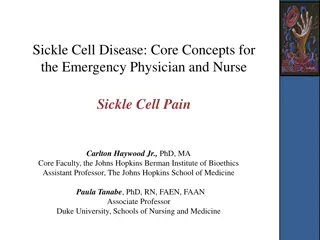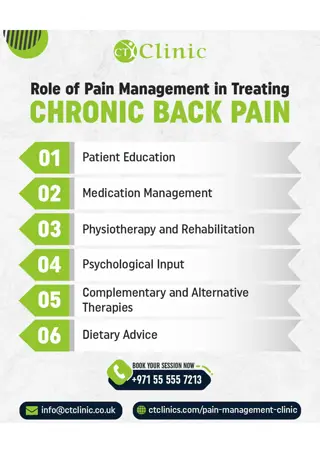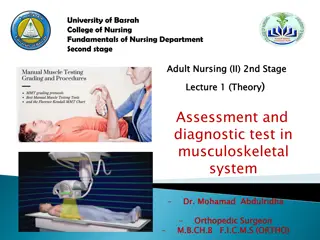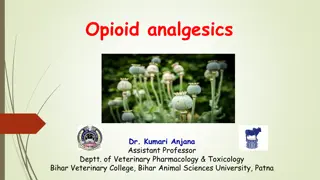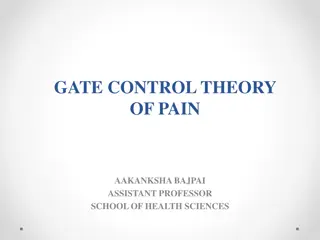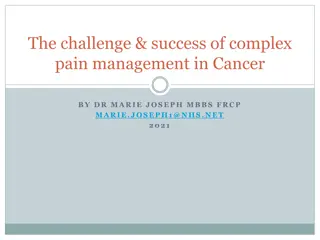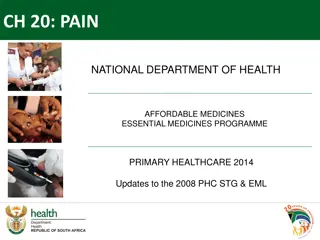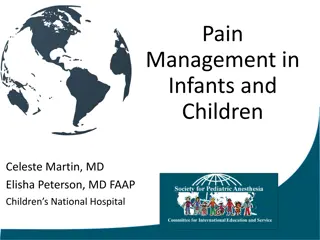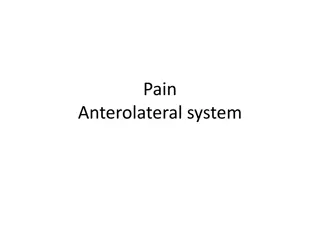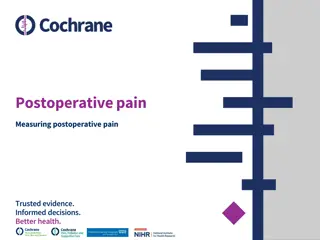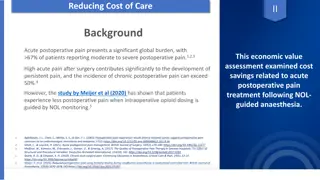Basic Pain Management Session Information
International Association for the Study of Pain defines pain as an unpleasant sensory and emotional experience associated with tissue damage. Learn about pain prevalence in advanced illnesses, management strategies, and the harmful effects of unrelieved pain.
Download Presentation

Please find below an Image/Link to download the presentation.
The content on the website is provided AS IS for your information and personal use only. It may not be sold, licensed, or shared on other websites without obtaining consent from the author.If you encounter any issues during the download, it is possible that the publisher has removed the file from their server.
You are allowed to download the files provided on this website for personal or commercial use, subject to the condition that they are used lawfully. All files are the property of their respective owners.
The content on the website is provided AS IS for your information and personal use only. It may not be sold, licensed, or shared on other websites without obtaining consent from the author.
E N D
Presentation Transcript
PAIN 101 BASIC PAIN MANAGEMENT
Disclosures I have no relationships with for-profit or not-for-profit organizations. This session/program has not received financial or in-kind support.
Learning objectives At the end of this session, participants will be able to: Select appropriate analgesia & adjuvant therapies Initiate, titrate, and rotate opioid doses effectively Manage breakthrough pain & opioid side effects
Definition of Pain International Association for the Study of Pain (IASP) defines PAIN as an unpleasant sensory and emotional experience associated with actual or potential tissue damage or described in such terms Highly unpleasant physical sensation caused by illness or injury Can causes mental distress or suffering Pain is always a subjective experience
Pain is a more terrible lord of mankind than death itself ~ Albert Schweitzer
Prevalence of pain in advance illness Cancer 80-90% of patients Often multiple types of pain End Stage Heart Failure 50-60% ALS/MS Up to 60% Neuropathic pain common
Many patients with advanced chronic disease also have painful co- morbidities (e.g. osteoarthritis, neuropathy from diabetes) at the end of life, functional decline, weight loss, development of skin breakdown, and contractures are also known sources of pain
Pain and stress responses, especially when prolonged, can produce harmful effects that involve multiple systems
Harmful effects of unrelieved or prolonged pain Cardiovascular increased HR, Increased vascular resistance, DVT, hypercoagulation Respiratory infection, decrease cough, atelectasis, decrease flows and volumes Genitourinary decrease urinary output, urinary retention, fluid overload, hypokalemia Gastrointestinal decrease gastric and bowel motility
Harmful effects of unrelieved or prolonged pain Musculoskeletal muscle spasms, fatigue, immobility, impaired muscle function Cognitive mental confusion, reduced cognitive function Immune depression of immune response Quality of Life sleeplessness, anxiety, fear, hopelessness, increased suicidal ideation
Routine assessment is essential for effective pain management
Pain Assessment Onset ~ When did it start? Acute or gradual onset? Pattern since onset? Provoking / palliating ~ What brings it on? What makes it better or worse Quality ~ Identify neuropathic pain Region / radiation Severity ~ Use verbal descriptors and/or 1 10 scale Treatment ~ Current and past treatment; side effects U/Understanding ~ how does it affect you; Meaning of the pain to the sufferer Values ~ Goals & expectations of management Physical Exam ~ Look for signs of tumour progression, trauma, or neuropathic etiology hypo- or hyper-esthesia, allodynia
Pain Assessment The Gold Standard for assessing pain is the individual s self report Self report measures use the individual s own report of their feelings, images, or statements about the pain that they perceive Pain is a subjective, multidimensional and highly variable experience for everyone regardless of age or special needs Whatever the person experiencing it says it is and occurs whenever he/she says it does (Margo McCaffery, 1999)
General Principle of Management Set the goal as reduction in pain to tolerable levels, not complete relief as in most cases this is not realistic Start low & go slow Make sure the patient and the family are aware of the goals Frequent visits initially for assurance, validation, reassessment & monitoring of titration
WHO Pain Ladder Step 3 Severe Pain 8-10 Step 2 Moderate pain 4-7 STRONG OPIOID Step 1 Hydromorphone Morphine Oxycodone WEAK OPIOID Tramadol Codeine Mild Pain 1-3 NON OPIOID Fentanyl Methadone +/- Adjuvant +/- Adjuvant +/- Adjuvant Consider other palliative modalities such as radiotherapy, palliative surgery as appropriate Address psychosocial needs Manage other concurrent symptoms
Non-opioid Analgesia Acetaminophen ~ concern for hepatic toxicity >3-4 grams daily NSAIDs including ibuprofen, COX-2 inhibitors ~ concern for gastric/renal toxicity, platelet dysfunction, may inhibit anti- hypertensive medications
Selecting Between Different Opioids Morphine & hydromorphone remain good strong opioids Individual patients respond differently to different opioids PO route is preferred (IV or SC if oral route not an option) Start with short acting formulations (IR immediate release) Long acting is a good option to alleviate routine dosing throughout the day and provide stable pain relief
Starting Opioids Generally start with short acting formulations (there are exceptions) Titrate to effect Change to long acting formulation once pain is controlled, to avoid several doses throughout the day and overnight, to simplify medications and provide a more stable pain control Individualize it to the patient s needs and circumstances and identify any hesitation or misconceptions that may cause the patient to not take the analgesia as prescribed KEEP IT SIMPLE
Common OPIOID Myths TRUE OR FALSE? Opioids shorten life ~ False Opioids invariably sedate patients ~ False Opioids are addictive ~False
Tolerance vs Dependence vs. Addiction Tolerance Over time larger doses are needed to achieve results NOT addiction Dependence Withdrawal symptoms can occur if opioid is suddenly discontinued or excessively reduced Addiction Psychological dependence a brain disease that is manifested by compulsive substance use despite harmful consequence
Common side effects- constipation Constipation is actually an effect of opioids and not a side effect, and requires ongoing laxative use The pen that writes the prescription for the opioid should also write one for a laxative Patient will likely need to titrate as required to achieve a large, soft bowel movement daily If constipation is not managed, it could lead to nausea, decreased appetite, bloating, pain/discomfort, decreased sense of well being, agitation/restlessness, delirium and bowel obstruction
Common side effects - Nausea Cause of nausea is often multi-factorial Usually resolved within a few days Low doses of opioids activate opioid receptors in the chemoreceptor trigger zone (CTZ) Appropriate antiemetics would include: metoclopramide 5-10mg PO or SC QID Domperidone 10mg PO TID Haldol 0.5mg-2mg PO/SC OD-BID Ondansetron 4mg-8m Q8hours
Common side effects - Somnolence Usually resolves within a few days Ensure that they are not driving until somnolence has subsided and pain is controlled
Less Common Side effects Neurotoxicity Exclude other causes for symptoms Clinical presentation may include: myoclonus, hallucinations, confusion, delirium, severe somnolence, increase in pain (dysethesia, allodynia) hydrate, rotate opioid, reduce opioid Respiratory depression Clinically significant respiratory depression is unlikely to occur if smaller doses are initiated in opioid na ve patients and titration is done slowly
OPIOID Starting dose Frail elderly, advanced lung & heart disease start with lower doses Morphine 2.5mg-5mg PO Q4hours Morphine (tabs/liquid); statex, MSCONTIN, M-Eslon, Kadian Hydromorphone 0.5mg-1mg PO Q4 hrs Hydromorphone (Dilaudid)(tabs/liquid) HydromorphCONTIN Codeine, Tylenol #1- 8mg/300mg Tylenol #2 -15 mg/300mg Tylenol #3 - 30mg/300mg Tylenol #4 60mg/300mg CodeineContin Codeine 15-30mg PO Q4hrs Oxycodone 5mg PO Q4hrs OxyIR, oxycodone, Percocet 5mg/325mg OxyCONTIN Tramadol/tramacet 37.5mg PO TID-QID Tramadol; Tramacet (tramadol 37.5mg/325mg acetaminophen)
Pharmacokinetics of Opioids Onset of pain relief ORAL S/C IV Duration of pain relief Short acting opioids Long acting Fentanyl patches Time frame 15-30 minutes 5-10 minutes 3-5 minutes Time frame 3-4 hours 8-12 hours 48-72 hours
Case study ~ Jenny Jenny is a 79 year old female with lung cancer She is having dyspnea, mostly with exertion but sometimes at rest She is also having chest wall pain, and worsening pain to her right posterior chest wall; Pain assessment: has slowly progressed over the last few months since diagnosis, but worse over the past week to her right posterior chest wall; activity makes it worse, rest and shallow breathing helps, but this makes her feel breathless, describes is as an aching pain, with occasional sharp pain, no burning or tingling, time of day does not change her pain; does not radiate anywhere; rates it as 9/10 at its worse and 3/10 at its best; acetaminophen takes the edge off a bit, but doesn t really help ; makes her worried that her cancer has spread, and has negative impaction on her QOL as she just wants to stay in bed when pain and breathing are bad; she understands that no pain is not realistic, but she does wish to have as much quality of life as possible and wishes to have the pain be more tolerable You ve assessed her medications, completed a physical assessment you believe that she would benefit from opioid to help with her dyspnea & pain; She has never been on an opioid analgesia before
Case study ~ Jenny You feel that hydromorphone would be helpful, call her palliative NP/MD and suggest: Hydromorphone 0.5mg PO Q 2hours PRN for pain & dyspnea Anything else to consider about the pain? Progression of disease? Boney mets?
Case study ~ Jenny CT scan completed and she is found to have new onset of metastatic cancer to the right posterior rib 7 and is now scheduled to have radiation Post radiation, Jenny is using the hydromorphone 0.5mg 2-3 times per day and feels that this is helpful to ease her breathing and make the pain tolerable; she uses the hydromorphone to keep her pain less than 4/10 which is what she feels is tolerable to her
Case study ~ Jenny Jenny is now taking the hydromorphone 1mg tablet every 2-4 hours and she feels that it is difficult to have to rely on taking the pills so often especially over night. What do we want to know? Is it helping? Has she been taking anything else? Is the pain worsening? Is she having difficulty swallowing the pills, is she taking the pills RTC including waking at night? How many mgs/day is she currently taking?
Case study ~ Jenny Jenny is taking 10-12mg of the hydromorphone IR every day now She feels it helps keep her pain tolerable and she is happy with that but finds it bothersome to take the pills so often and if she sleeps through she wakes in excruciating pain What would you suggest? hydromorphCONTIN. How much? hydromorphCONTIN 6mg PO Q12hours
Breakthrough medication Breakthrough dose should be approximately 10% of the total daily opioid dose given q1-3 hours May need to titrate the dose according to the patient s needs Generally use the same opioid as being used for the regular regime (scheduled short acting or long acting opioid) except with fentanyl patch So what dose would be suggest for Jenny? 1mg Q2hours PRN for breakthrough pain
Titrating dose of opioid What would you do if the next time you saw Jenny she reported using the hydromorphCONTIN 6mg Q12hours plus was using 1mg breakthrough dose 5-6 times per day? Consider increasing her long acting? To 9mg PO Q12hours But what if she told you she was comfortable most of the day but found her pain flared first thing in the mornings before she took her long acting and then again in the afternoon? She likely requires an increase in medication but you may also want to consider change the long acting to Q8hour dosing as she may be having dose end failure
Equianalgesia & Opioid Rotation Increase the dose by 25% -50% if the patient is not achieving adequate pain control Take into account the number of breakthrough doses taken Morphine is the GOLD standard for opioid rotation OPIOID MORPHINE HYDROMORPHONE CODEINE OXYCODONE PO DOSE IV/SC DOSE 10mg 2mg 100mg 5mg 5mg 1mg --- ---
Rotating opioids What if Jenny was taking M-Eslon 20mg PO Q12hours and was taking statex 5mg PO q 2hours PRN for pain and you felt rotating the opioid was necessary Jenny confirms that she is typically taking an additional 20mg of morphine daily (statex 5mg x 4 doses) You decide you d like to rotate her opioid to hydromorphone 20mg Q12hours = 40mg + 20mg (PRN doses) = 60mg/24hours 60mg / 5 = 12mg
Incomplete Cross-tolerance The tolerance a patient has built towards one opioid my not completely transfer to the new opioid Due to incomplete cross-tolerance, it is recommended that you reduce the new opioid by 50% of the Equianalgesia dose Therefore you would consider starting Jenny with hydromorphone 6mg/day (60mg / 5 = 12mg) (12mg / 50% = 6mg) You would then consider hydromorphone 3mg PO Q12hours with a dose of hydromorphone IR Q 2hours for breakthrough pain. What dose would you consider for breakthrough?
Equianalgesia Fentanyl Patch You will find different ranges depending on the resource you use Fentanyl is 50 to 100 times more potent that morphine Morphine is the GOLD STANDARD for opioid rotation MORPHINE dose Mg PO/24 hours 25-59 60-134 135-179 180- 224 225-269 270-314 315-404 405-494 594-584 Transdermal FENTANYL dose Mcg/hr q72 hours 12 25 37 50 62 75 100 125 150
Case study ~ Jenny Weeks later, Jenny is unable to tolerate the PO medication, but her prognosis is still considered to be many weeks perhaps months and she is not interested in having an infusion pump, but she asks if there are other options for her versus the oral medication She is taking hydromorphone 6mg PO Q12hr plus 3mg PO daily for breakthrough (total 15mg daily) You talk to her about the fentanyl patch, what dose would you recommend? 15mg x 5 = 75mg 75mg 50% (incomplete cross tolerance) = 37.5mg (PO morphine equivalent)
Adjuvant therapies for bone pain NSAIDs Limited use in severe pain Renal & GI side effects Steroids Useful in pain crisis 4mg PO OD 8mg PO TID x 1-3 weeks to settle crisis Radiotherapy 75% - 85% response rate (decrease pain) Flare of pain before we see improvement Few side effects with palliative therapy Response within 1-2 weeks (up to 4 weeks later) and can last several months
Adjuvant therapies for bone pain Bisphosphonates Breast, prostate cancers and multiple myeloma Reduction of skeletal events (good evidence) Surgery Impending or pathological fractures
Adjuvant therapiesneuropathic pain Gabapentin start at 100mg PO daily at HS and titrate up by 100 every few days if tolerated; renal dosing required Pregabulin start 25-75mg PO daily at HS, titrate as tolerated every few days; renal dosing TCAs nortriptyline 10mg , desipramine 12.5mg; amitriptyline 10mg Steroids Cannabinoids
Adjuvant therapies Visceral pain Liver metastases or malignant bowel obstruction Corticosteroids (dexamethasone 2-8mg OD to BID octreotide (sandostatin) 200-900mcg/day in 2-3 doses Colic - buscopan (hyoscine butyl bromide) 10mg s/c
The quality of every patients life and dying process is dependent on the quality of their pain and symptom management ~ R. Goldman
Conclusion Pain is always a subjective experience & can causes mental distress or suffering Pain is prevalent in end of life regardless of the illness Many patients may also have painful co-morbidities to address at the end of life, functional decline, weight loss, development of skin breakdown, and contractures are also known sources of pain Unrelieved, prolonged pain can have harmful effects Routine assessment is essential for effective pain management Opioids are an effective way to manage moderate to severe pain in end of life Start low & go slow Titrate opioids to the best analgesia with the fewest side effects Use adjuvant medications & treatments when appropriate Education patient & family



